Financial Analysis: Cost Structure of Global Manufacturing Firms
VerifiedAdded on 2021/12/20
|11
|1256
|74
Report
AI Summary
This report provides an in-depth analysis of the cost structures of three global companies: Volkswagen, Toyota, and Alcoa. The report examines the companies' financial data, focusing on the identification and classification of fixed and variable costs. It explores the impact of various factors, such as expansion, investment, and technological advancements, on the cost structures. The analysis includes a detailed overview of the companies' backgrounds, revenue, and expenses, drawing insights from their 2017 annual reports. The report also explains the methodology for calculating fixed and variable costs using hypothetical examples and data extracted from the annual reports. The conclusion emphasizes the challenges in accurately categorizing costs based on financial data alone and highlights the importance of understanding cost behavior for effective management accounting practices.
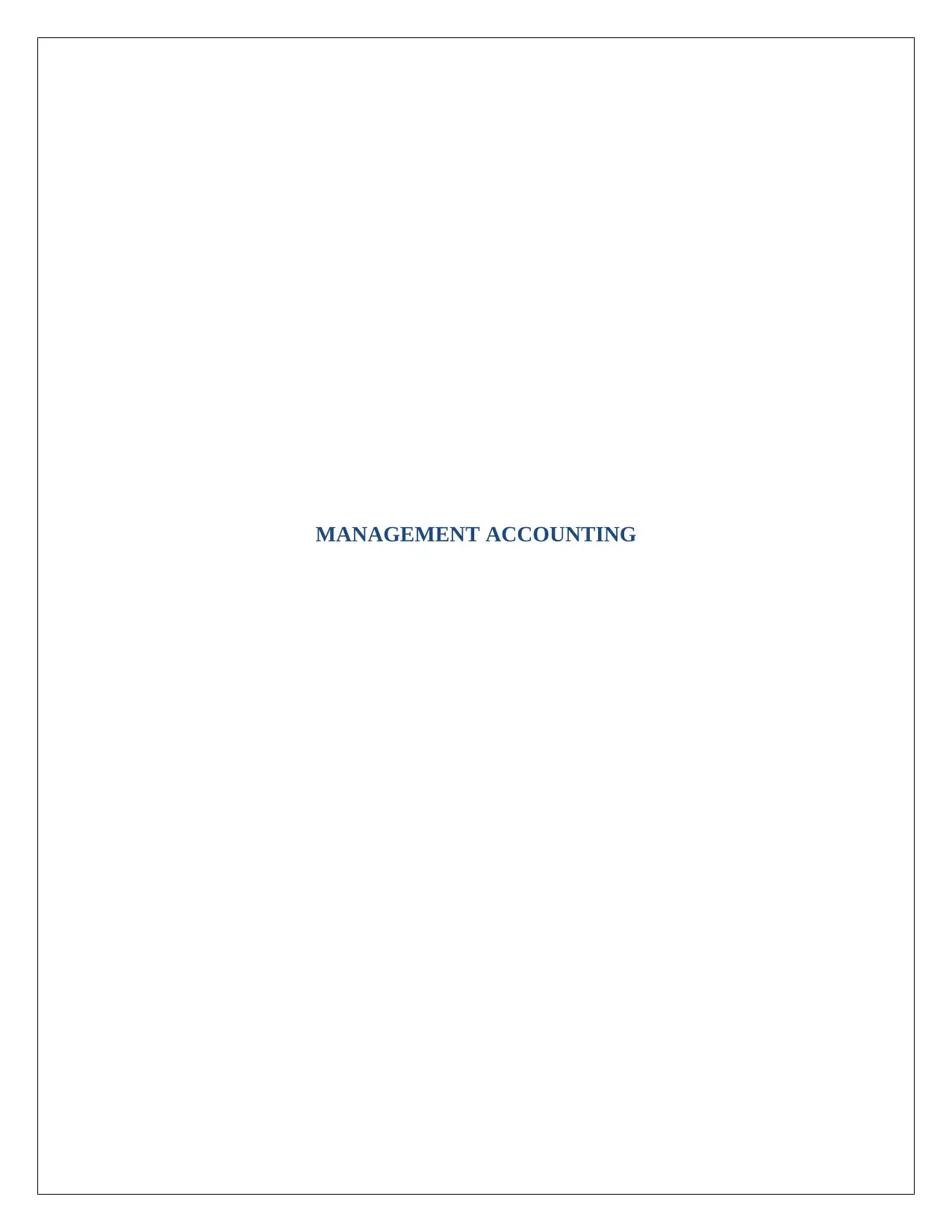
MANAGEMENT ACCOUNTING
Paraphrase This Document
Need a fresh take? Get an instant paraphrase of this document with our AI Paraphraser
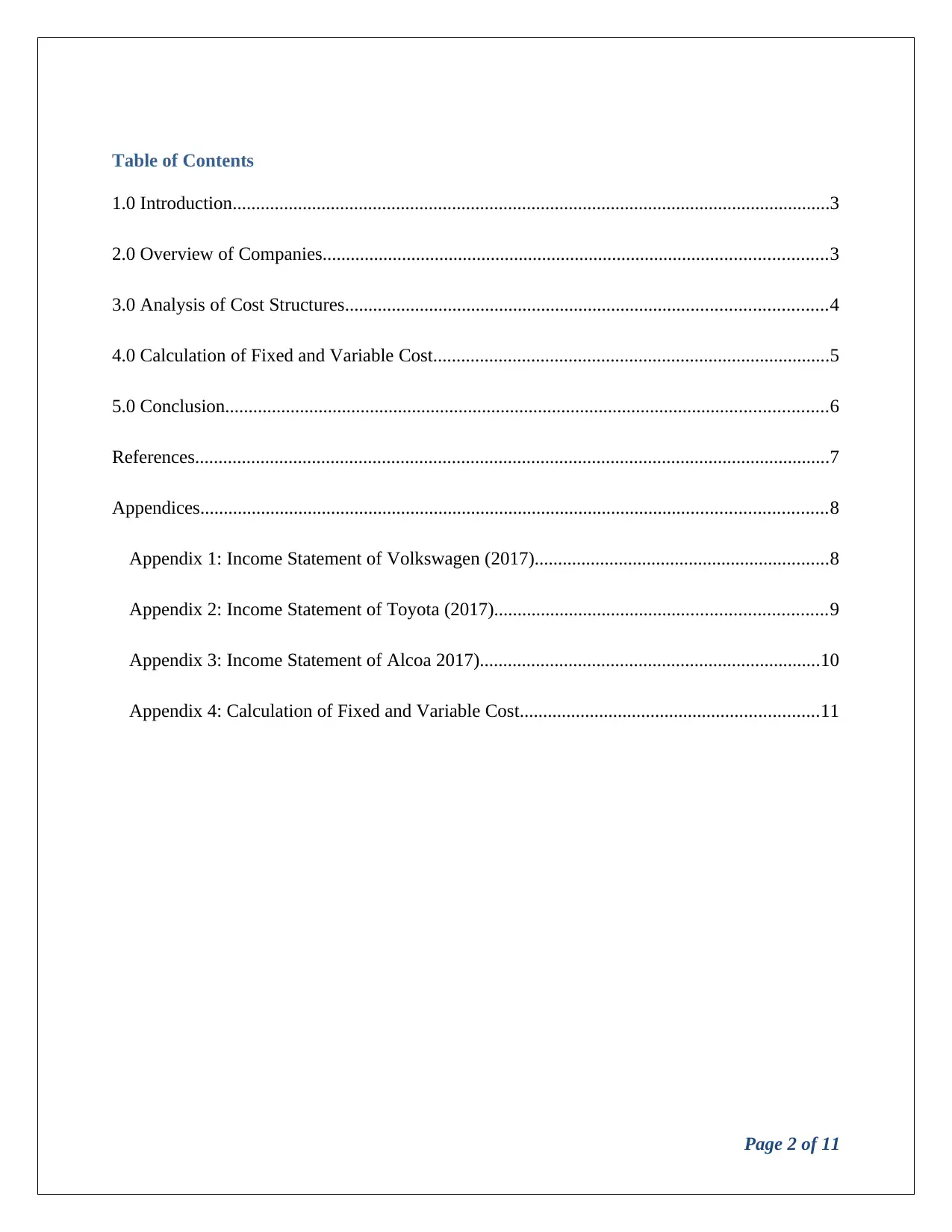
Table of Contents
1.0 Introduction................................................................................................................................3
2.0 Overview of Companies............................................................................................................3
3.0 Analysis of Cost Structures.......................................................................................................4
4.0 Calculation of Fixed and Variable Cost.....................................................................................5
5.0 Conclusion.................................................................................................................................6
References........................................................................................................................................7
Appendices......................................................................................................................................8
Appendix 1: Income Statement of Volkswagen (2017)...............................................................8
Appendix 2: Income Statement of Toyota (2017).......................................................................9
Appendix 3: Income Statement of Alcoa 2017).........................................................................10
Appendix 4: Calculation of Fixed and Variable Cost................................................................11
Page 2 of 11
1.0 Introduction................................................................................................................................3
2.0 Overview of Companies............................................................................................................3
3.0 Analysis of Cost Structures.......................................................................................................4
4.0 Calculation of Fixed and Variable Cost.....................................................................................5
5.0 Conclusion.................................................................................................................................6
References........................................................................................................................................7
Appendices......................................................................................................................................8
Appendix 1: Income Statement of Volkswagen (2017)...............................................................8
Appendix 2: Income Statement of Toyota (2017).......................................................................9
Appendix 3: Income Statement of Alcoa 2017).........................................................................10
Appendix 4: Calculation of Fixed and Variable Cost................................................................11
Page 2 of 11
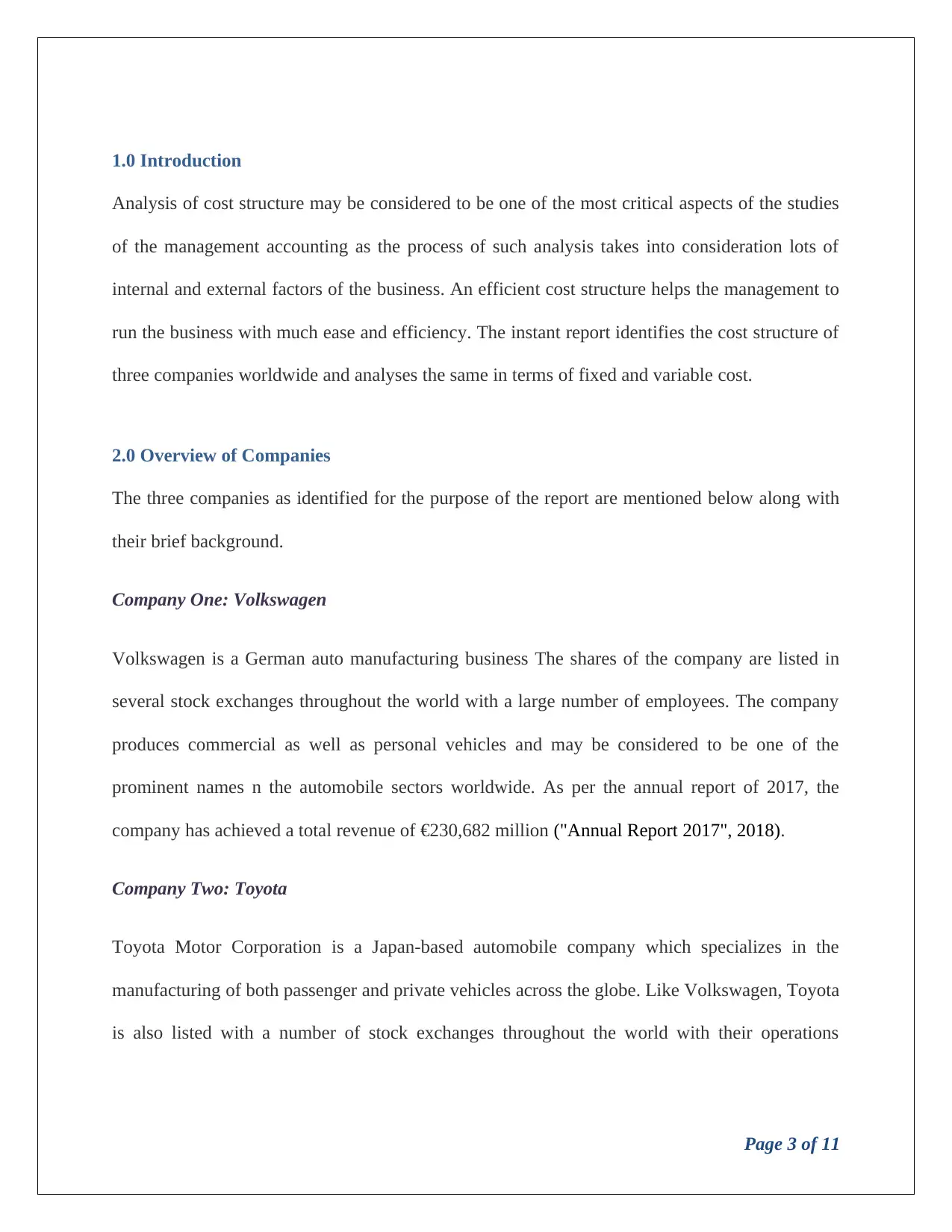
1.0 Introduction
Analysis of cost structure may be considered to be one of the most critical aspects of the studies
of the management accounting as the process of such analysis takes into consideration lots of
internal and external factors of the business. An efficient cost structure helps the management to
run the business with much ease and efficiency. The instant report identifies the cost structure of
three companies worldwide and analyses the same in terms of fixed and variable cost.
2.0 Overview of Companies
The three companies as identified for the purpose of the report are mentioned below along with
their brief background.
Company One: Volkswagen
Volkswagen is a German auto manufacturing business The shares of the company are listed in
several stock exchanges throughout the world with a large number of employees. The company
produces commercial as well as personal vehicles and may be considered to be one of the
prominent names n the automobile sectors worldwide. As per the annual report of 2017, the
company has achieved a total revenue of €230,682 million ("Annual Report 2017", 2018).
Company Two: Toyota
Toyota Motor Corporation is a Japan-based automobile company which specializes in the
manufacturing of both passenger and private vehicles across the globe. Like Volkswagen, Toyota
is also listed with a number of stock exchanges throughout the world with their operations
Page 3 of 11
Analysis of cost structure may be considered to be one of the most critical aspects of the studies
of the management accounting as the process of such analysis takes into consideration lots of
internal and external factors of the business. An efficient cost structure helps the management to
run the business with much ease and efficiency. The instant report identifies the cost structure of
three companies worldwide and analyses the same in terms of fixed and variable cost.
2.0 Overview of Companies
The three companies as identified for the purpose of the report are mentioned below along with
their brief background.
Company One: Volkswagen
Volkswagen is a German auto manufacturing business The shares of the company are listed in
several stock exchanges throughout the world with a large number of employees. The company
produces commercial as well as personal vehicles and may be considered to be one of the
prominent names n the automobile sectors worldwide. As per the annual report of 2017, the
company has achieved a total revenue of €230,682 million ("Annual Report 2017", 2018).
Company Two: Toyota
Toyota Motor Corporation is a Japan-based automobile company which specializes in the
manufacturing of both passenger and private vehicles across the globe. Like Volkswagen, Toyota
is also listed with a number of stock exchanges throughout the world with their operations
Page 3 of 11
⊘ This is a preview!⊘
Do you want full access?
Subscribe today to unlock all pages.

Trusted by 1+ million students worldwide
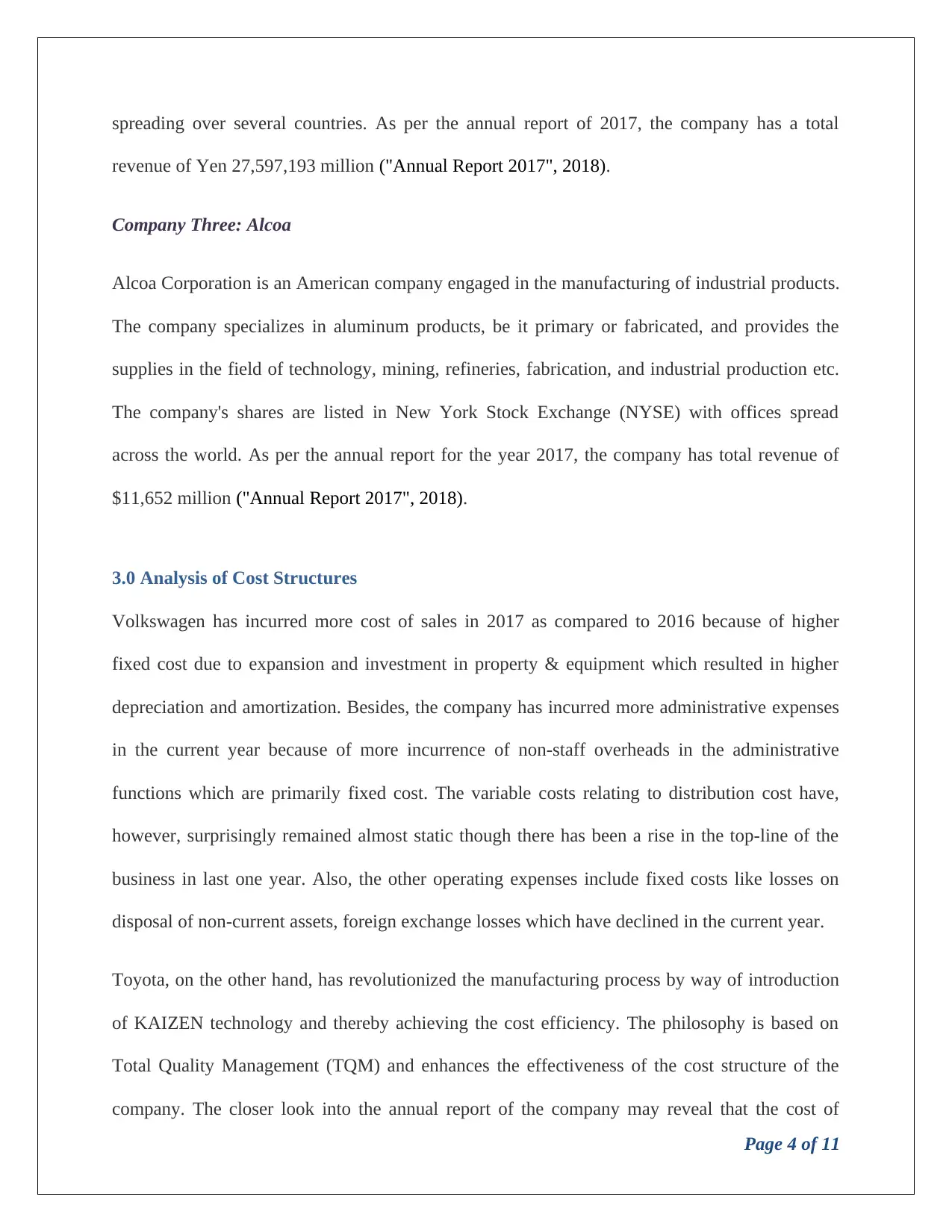
spreading over several countries. As per the annual report of 2017, the company has a total
revenue of Yen 27,597,193 million ("Annual Report 2017", 2018).
Company Three: Alcoa
Alcoa Corporation is an American company engaged in the manufacturing of industrial products.
The company specializes in aluminum products, be it primary or fabricated, and provides the
supplies in the field of technology, mining, refineries, fabrication, and industrial production etc.
The company's shares are listed in New York Stock Exchange (NYSE) with offices spread
across the world. As per the annual report for the year 2017, the company has total revenue of
$11,652 million ("Annual Report 2017", 2018).
3.0 Analysis of Cost Structures
Volkswagen has incurred more cost of sales in 2017 as compared to 2016 because of higher
fixed cost due to expansion and investment in property & equipment which resulted in higher
depreciation and amortization. Besides, the company has incurred more administrative expenses
in the current year because of more incurrence of non-staff overheads in the administrative
functions which are primarily fixed cost. The variable costs relating to distribution cost have,
however, surprisingly remained almost static though there has been a rise in the top-line of the
business in last one year. Also, the other operating expenses include fixed costs like losses on
disposal of non-current assets, foreign exchange losses which have declined in the current year.
Toyota, on the other hand, has revolutionized the manufacturing process by way of introduction
of KAIZEN technology and thereby achieving the cost efficiency. The philosophy is based on
Total Quality Management (TQM) and enhances the effectiveness of the cost structure of the
company. The closer look into the annual report of the company may reveal that the cost of
Page 4 of 11
revenue of Yen 27,597,193 million ("Annual Report 2017", 2018).
Company Three: Alcoa
Alcoa Corporation is an American company engaged in the manufacturing of industrial products.
The company specializes in aluminum products, be it primary or fabricated, and provides the
supplies in the field of technology, mining, refineries, fabrication, and industrial production etc.
The company's shares are listed in New York Stock Exchange (NYSE) with offices spread
across the world. As per the annual report for the year 2017, the company has total revenue of
$11,652 million ("Annual Report 2017", 2018).
3.0 Analysis of Cost Structures
Volkswagen has incurred more cost of sales in 2017 as compared to 2016 because of higher
fixed cost due to expansion and investment in property & equipment which resulted in higher
depreciation and amortization. Besides, the company has incurred more administrative expenses
in the current year because of more incurrence of non-staff overheads in the administrative
functions which are primarily fixed cost. The variable costs relating to distribution cost have,
however, surprisingly remained almost static though there has been a rise in the top-line of the
business in last one year. Also, the other operating expenses include fixed costs like losses on
disposal of non-current assets, foreign exchange losses which have declined in the current year.
Toyota, on the other hand, has revolutionized the manufacturing process by way of introduction
of KAIZEN technology and thereby achieving the cost efficiency. The philosophy is based on
Total Quality Management (TQM) and enhances the effectiveness of the cost structure of the
company. The closer look into the annual report of the company may reveal that the cost of
Page 4 of 11
Paraphrase This Document
Need a fresh take? Get an instant paraphrase of this document with our AI Paraphraser
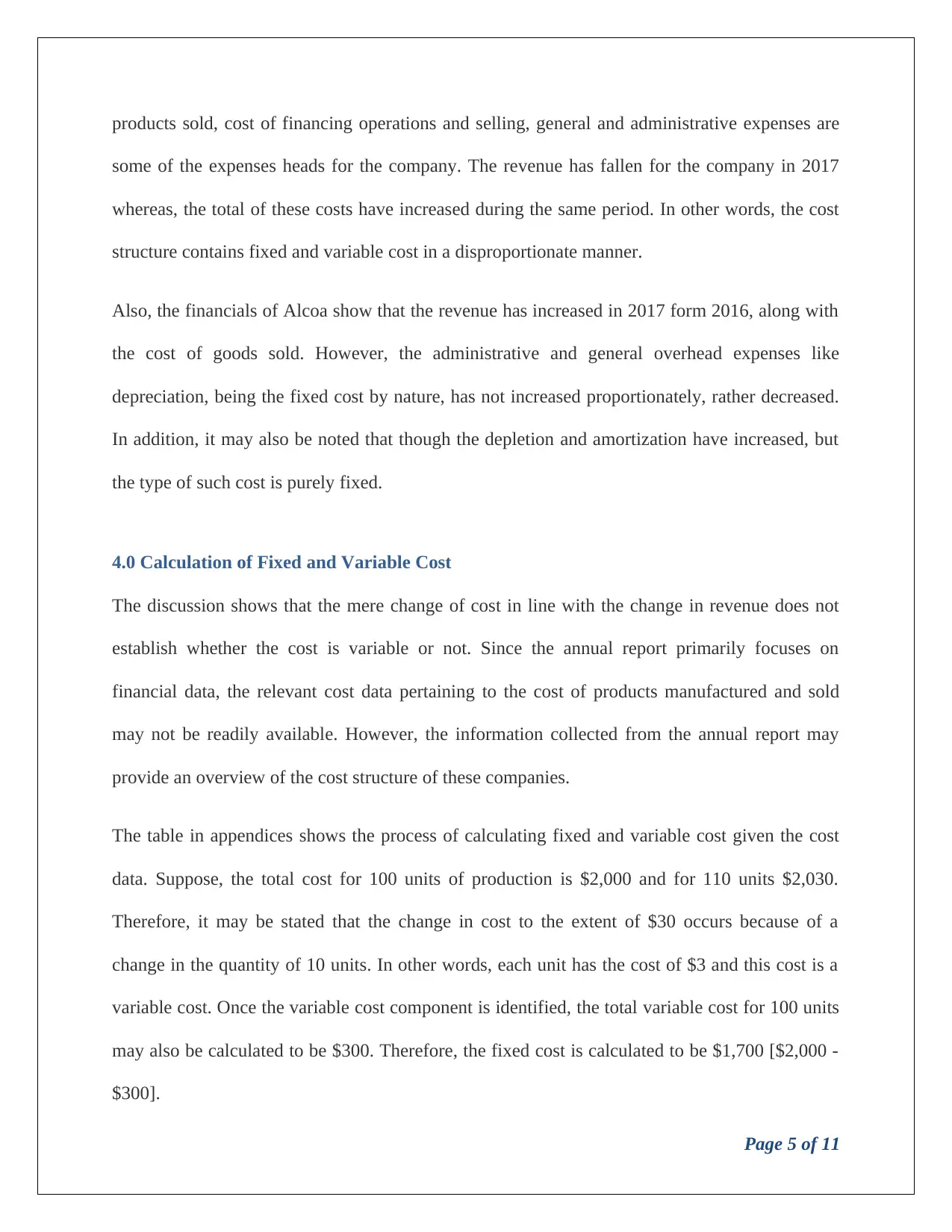
products sold, cost of financing operations and selling, general and administrative expenses are
some of the expenses heads for the company. The revenue has fallen for the company in 2017
whereas, the total of these costs have increased during the same period. In other words, the cost
structure contains fixed and variable cost in a disproportionate manner.
Also, the financials of Alcoa show that the revenue has increased in 2017 form 2016, along with
the cost of goods sold. However, the administrative and general overhead expenses like
depreciation, being the fixed cost by nature, has not increased proportionately, rather decreased.
In addition, it may also be noted that though the depletion and amortization have increased, but
the type of such cost is purely fixed.
4.0 Calculation of Fixed and Variable Cost
The discussion shows that the mere change of cost in line with the change in revenue does not
establish whether the cost is variable or not. Since the annual report primarily focuses on
financial data, the relevant cost data pertaining to the cost of products manufactured and sold
may not be readily available. However, the information collected from the annual report may
provide an overview of the cost structure of these companies.
The table in appendices shows the process of calculating fixed and variable cost given the cost
data. Suppose, the total cost for 100 units of production is $2,000 and for 110 units $2,030.
Therefore, it may be stated that the change in cost to the extent of $30 occurs because of a
change in the quantity of 10 units. In other words, each unit has the cost of $3 and this cost is a
variable cost. Once the variable cost component is identified, the total variable cost for 100 units
may also be calculated to be $300. Therefore, the fixed cost is calculated to be $1,700 [$2,000 -
$300].
Page 5 of 11
some of the expenses heads for the company. The revenue has fallen for the company in 2017
whereas, the total of these costs have increased during the same period. In other words, the cost
structure contains fixed and variable cost in a disproportionate manner.
Also, the financials of Alcoa show that the revenue has increased in 2017 form 2016, along with
the cost of goods sold. However, the administrative and general overhead expenses like
depreciation, being the fixed cost by nature, has not increased proportionately, rather decreased.
In addition, it may also be noted that though the depletion and amortization have increased, but
the type of such cost is purely fixed.
4.0 Calculation of Fixed and Variable Cost
The discussion shows that the mere change of cost in line with the change in revenue does not
establish whether the cost is variable or not. Since the annual report primarily focuses on
financial data, the relevant cost data pertaining to the cost of products manufactured and sold
may not be readily available. However, the information collected from the annual report may
provide an overview of the cost structure of these companies.
The table in appendices shows the process of calculating fixed and variable cost given the cost
data. Suppose, the total cost for 100 units of production is $2,000 and for 110 units $2,030.
Therefore, it may be stated that the change in cost to the extent of $30 occurs because of a
change in the quantity of 10 units. In other words, each unit has the cost of $3 and this cost is a
variable cost. Once the variable cost component is identified, the total variable cost for 100 units
may also be calculated to be $300. Therefore, the fixed cost is calculated to be $1,700 [$2,000 -
$300].
Page 5 of 11
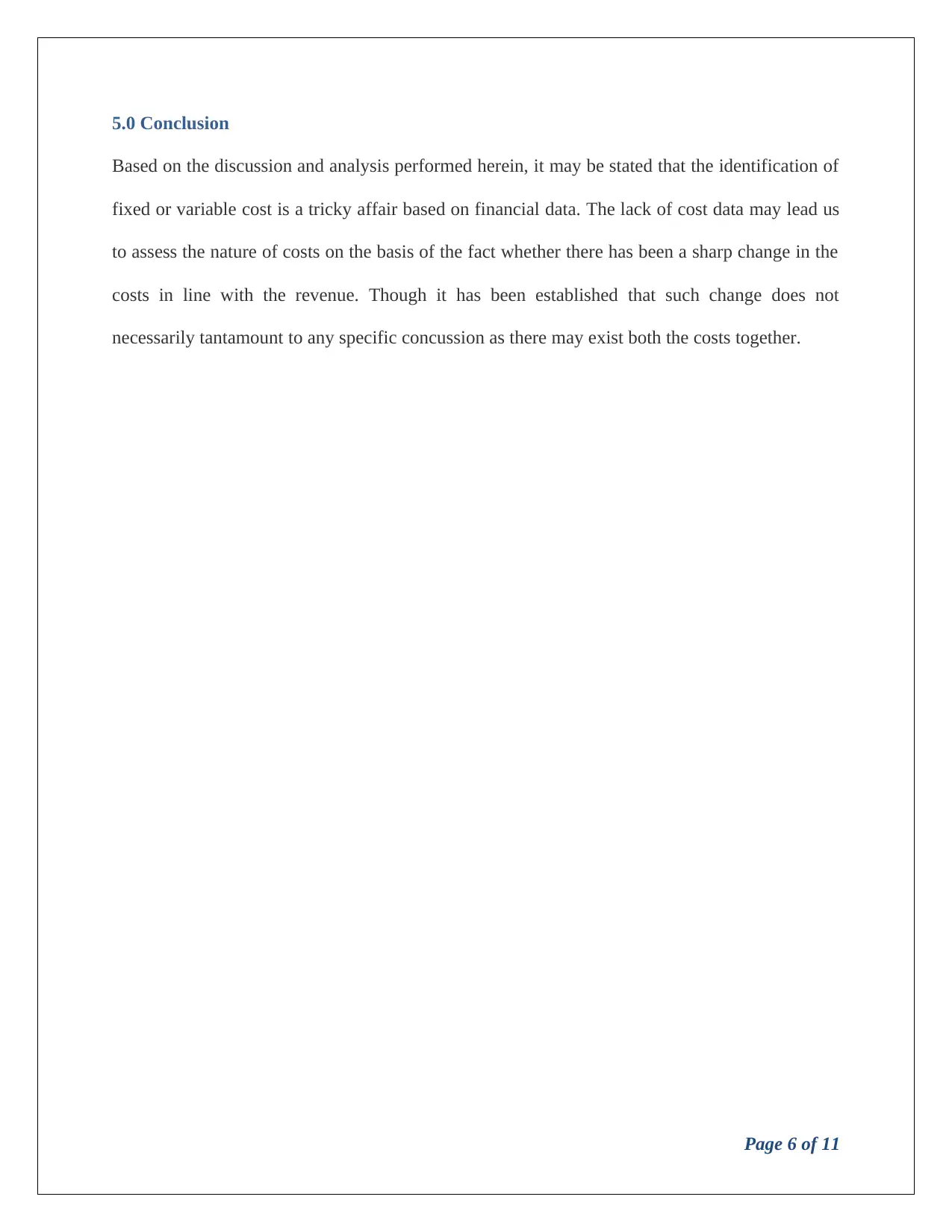
5.0 Conclusion
Based on the discussion and analysis performed herein, it may be stated that the identification of
fixed or variable cost is a tricky affair based on financial data. The lack of cost data may lead us
to assess the nature of costs on the basis of the fact whether there has been a sharp change in the
costs in line with the revenue. Though it has been established that such change does not
necessarily tantamount to any specific concussion as there may exist both the costs together.
Page 6 of 11
Based on the discussion and analysis performed herein, it may be stated that the identification of
fixed or variable cost is a tricky affair based on financial data. The lack of cost data may lead us
to assess the nature of costs on the basis of the fact whether there has been a sharp change in the
costs in line with the revenue. Though it has been established that such change does not
necessarily tantamount to any specific concussion as there may exist both the costs together.
Page 6 of 11
⊘ This is a preview!⊘
Do you want full access?
Subscribe today to unlock all pages.

Trusted by 1+ million students worldwide

References
Annual Report 2017. (2018). Retrieved from
http://annualreport2017.volkswagenag.com/servicepages/downloads/files/
entire_vw_ar17.pdf
Annual Report 2017. (2018). Retrieved from http://investors.alcoa.com/~/media/Files/A/Alcoa-
IR/documents/annual-reports-and-proxy-information/annual-report-2017.pdf
Annual Report 2017. (2018). Retrieved from
https://www.toyota-global.com/pages/contents/investors/ir_library/annual/pdf/2017/
annual_report_2017_fie.pdf
Page 7 of 11
Annual Report 2017. (2018). Retrieved from
http://annualreport2017.volkswagenag.com/servicepages/downloads/files/
entire_vw_ar17.pdf
Annual Report 2017. (2018). Retrieved from http://investors.alcoa.com/~/media/Files/A/Alcoa-
IR/documents/annual-reports-and-proxy-information/annual-report-2017.pdf
Annual Report 2017. (2018). Retrieved from
https://www.toyota-global.com/pages/contents/investors/ir_library/annual/pdf/2017/
annual_report_2017_fie.pdf
Page 7 of 11
Paraphrase This Document
Need a fresh take? Get an instant paraphrase of this document with our AI Paraphraser
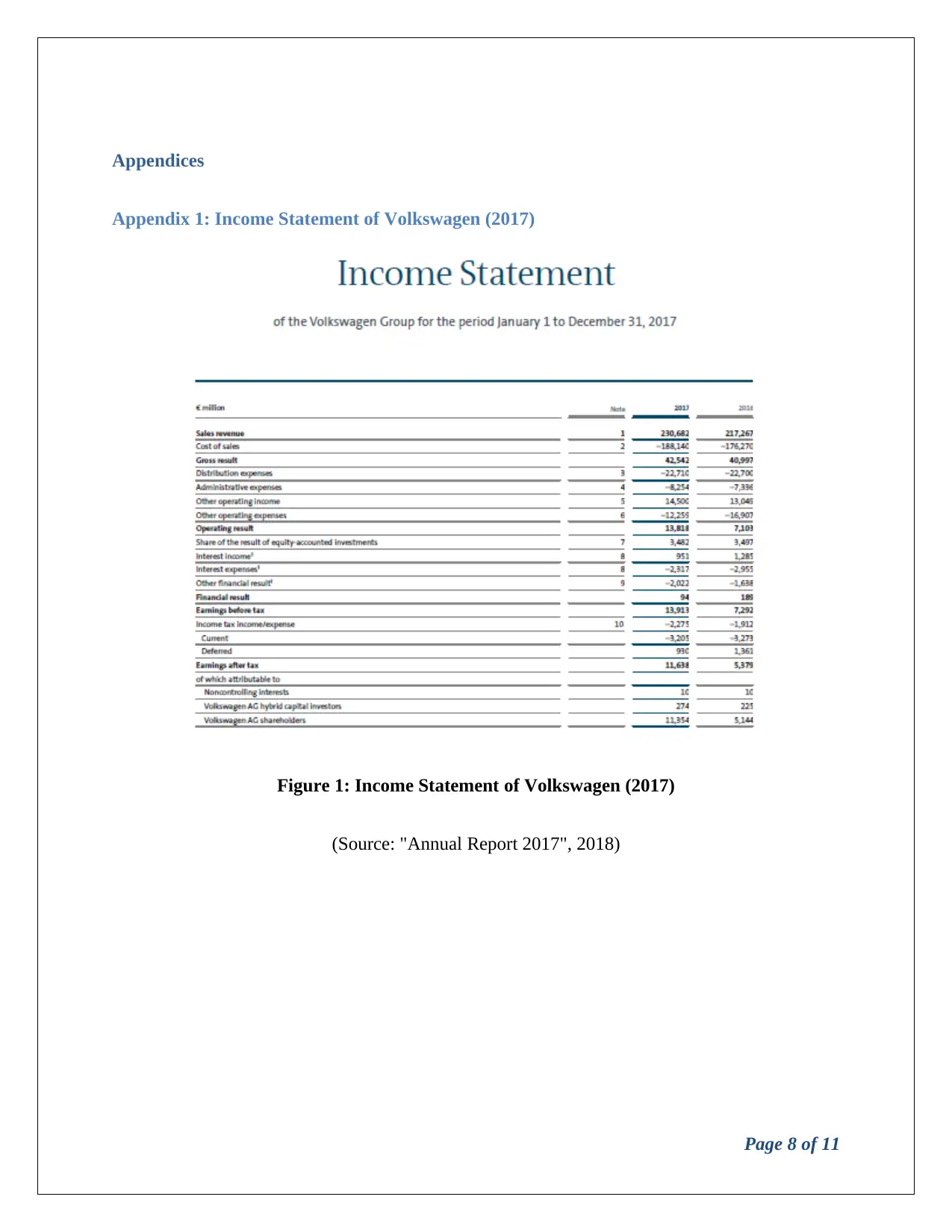
Appendices
Appendix 1: Income Statement of Volkswagen (2017)
Figure 1: Income Statement of Volkswagen (2017)
(Source: "Annual Report 2017", 2018)
Page 8 of 11
Appendix 1: Income Statement of Volkswagen (2017)
Figure 1: Income Statement of Volkswagen (2017)
(Source: "Annual Report 2017", 2018)
Page 8 of 11
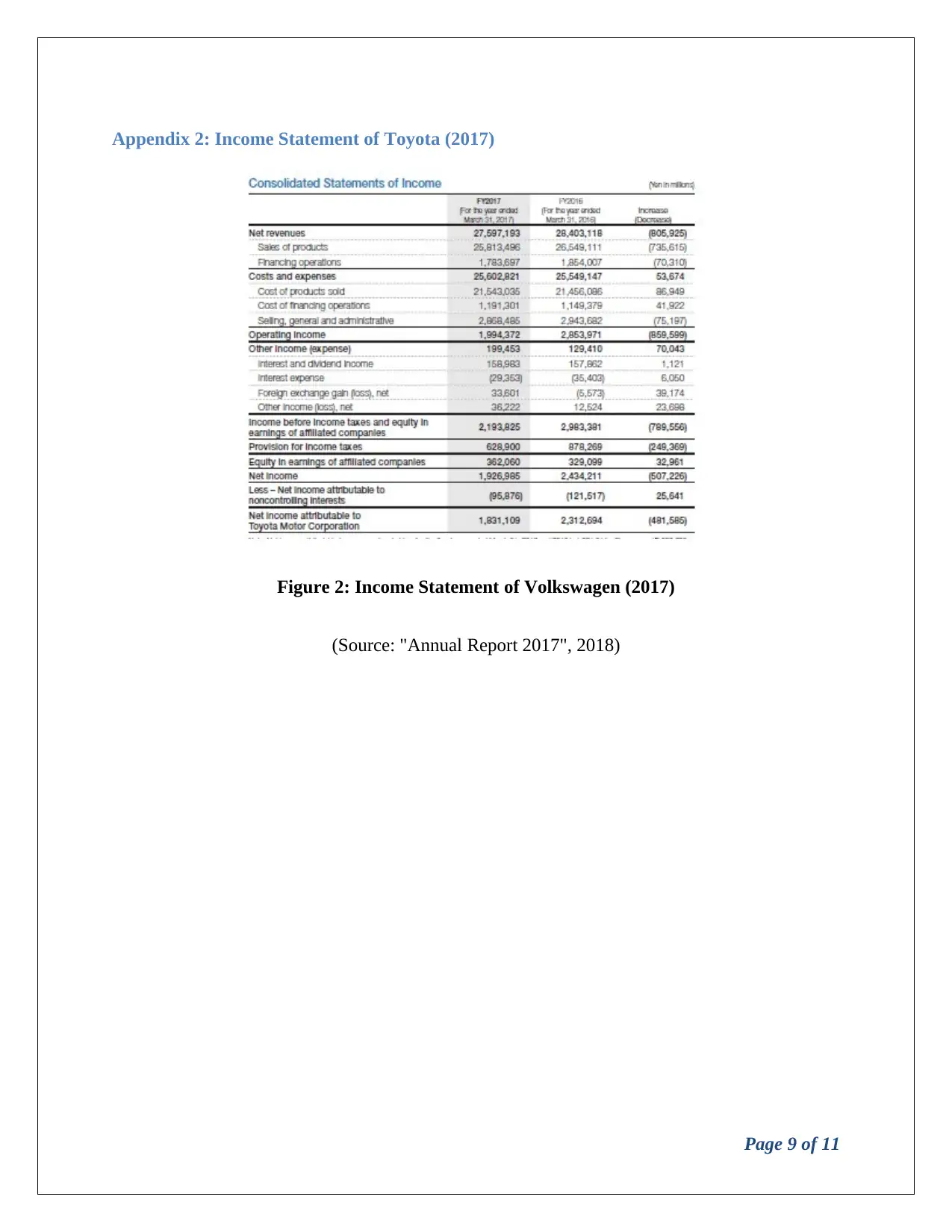
Appendix 2: Income Statement of Toyota (2017)
Figure 2: Income Statement of Volkswagen (2017)
(Source: "Annual Report 2017", 2018)
Page 9 of 11
Figure 2: Income Statement of Volkswagen (2017)
(Source: "Annual Report 2017", 2018)
Page 9 of 11
⊘ This is a preview!⊘
Do you want full access?
Subscribe today to unlock all pages.

Trusted by 1+ million students worldwide

Appendix 3: Income Statement of Alcoa 2017)
Figure 3: Income Statement of Alcoa (2017)
(Source: "Annual Report 2017", 2018)
Page 10 of 11
Figure 3: Income Statement of Alcoa (2017)
(Source: "Annual Report 2017", 2018)
Page 10 of 11
Paraphrase This Document
Need a fresh take? Get an instant paraphrase of this document with our AI Paraphraser
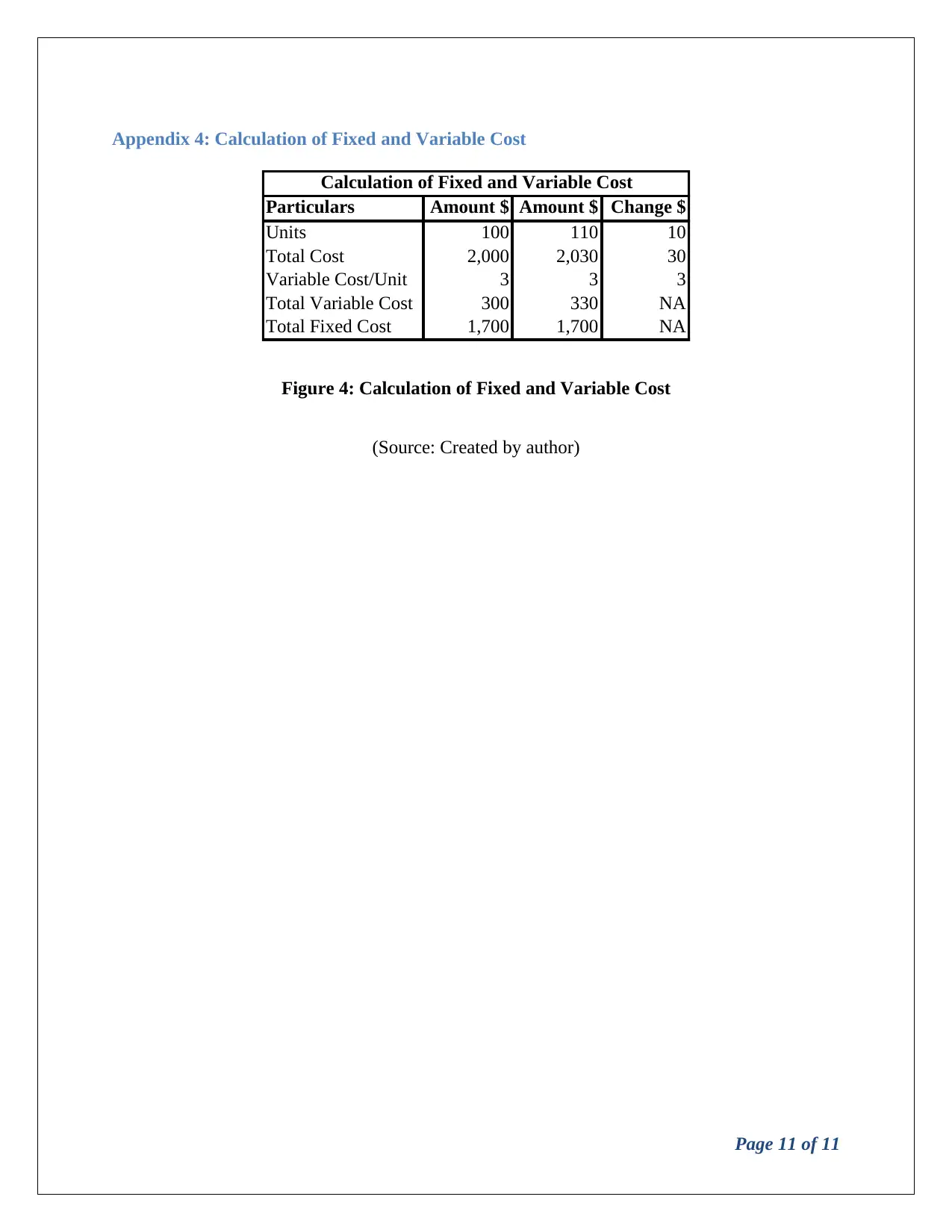
Appendix 4: Calculation of Fixed and Variable Cost
Particulars Amount $ Amount $ Change $
Units 100 110 10
Total Cost 2,000 2,030 30
Variable Cost/Unit 3 3 3
Total Variable Cost 300 330 NA
Total Fixed Cost 1,700 1,700 NA
Calculation of Fixed and Variable Cost
Figure 4: Calculation of Fixed and Variable Cost
(Source: Created by author)
Page 11 of 11
Particulars Amount $ Amount $ Change $
Units 100 110 10
Total Cost 2,000 2,030 30
Variable Cost/Unit 3 3 3
Total Variable Cost 300 330 NA
Total Fixed Cost 1,700 1,700 NA
Calculation of Fixed and Variable Cost
Figure 4: Calculation of Fixed and Variable Cost
(Source: Created by author)
Page 11 of 11
1 out of 11
Related Documents
Your All-in-One AI-Powered Toolkit for Academic Success.
+13062052269
info@desklib.com
Available 24*7 on WhatsApp / Email
![[object Object]](/_next/static/media/star-bottom.7253800d.svg)
Unlock your academic potential
Copyright © 2020–2025 A2Z Services. All Rights Reserved. Developed and managed by ZUCOL.





